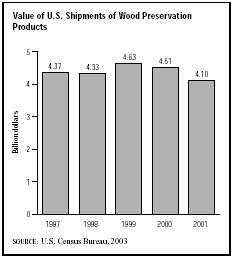SIC 2491
WOOD PRESERVING
The wood preserving industry is comprised of establishments primarily engaged in treating wood—sawed or planed in other establishments—with creosote or other preservatives to prevent decay and protect against fire and insects. The industry also cuts, treats, and sells poles, posts, and pilings; however, establishments primarily engaged in manufacturing other wood products, which they may also treat with preservatives, are classified elsewhere.
NAICS Code(s)
321114 (Wood Preservation)
People have been coating wood with crude preservatives, such as tar and pitch, for ages. Chemicals and processes developed during the nineteenth and twentieth centuries, however, have resulted in techniques for preserving wood for 35 years or more. Untreated wood exposed to the elements typically lasts about three years. Perhaps the greatest industry innovation during the 1900s was the high-pressure chemical treatment process, which accelerated wood's absorption of preservatives and increased the treatment's depth. During the 1990s and early 2000s, 95 percent of all preserved wood was treated using this process. Southern yellow pine accounts for 85 percent of all treated wood; the remaining 15 percent includes spruce-pine-fir, hemlock, Douglas fir, cedar, inland species of Ponderosa pine, and Brazilian pine. Demand for treated hardwoods is quite low.
Wood poles, piles, and posts owned and treated by the same establishment accounted for $617.02 million (roughly 15 percent) of the $4.1 billion in total industry shipments, according to the U.S. Census Bureau. Other wood products accounted for $3.06 billion (74 percent) in shipments, and contract wood preservation accounted for $151.43 million (11 percent) in shipments. Alabama and South Carolina were the top two states in value of product shipments, with Georgia and Virginia vying for third place.
The majority of wood products are treated with water-borne preservatives, the most common being chromated copper arsenate (CCA), ammoniacal copper quat (ACQ), and ammoniacal copper zinc arsenate (ACZA). Materials for decking, fences, gazebos, playgrounds, and the like are usually treated with this method. Pentachlorophenol, an oil-borne preservative, is used on utility poles and glued-laminated beams for vaulted ceilings.
Wood preservers have needed to adjust to new environmental restrictions. In 1990, the Environmental Protection Agency (EPA) identified the byproducts of wood preserving processes as hazardous waste and began regulating

the industry in 1991. Naphthenate and other substitutes increasingly offered viable alternatives to preservatives that spawn high-cost toxins. In 1996, Koppers Industries, an industry leader, reported ongoing problems with site and ground-water contamination from wood preservatives and had EPA violations at many of their facilities. The company reported the possibility of needing to install additional pollution control and monitoring devices at various facilities, and they participated in extensive cleanup operations.
The industry continues to deny that any pollution problems exist, despite research that shows that arsenic, in particular, leaches into the ground and water system, as well as rubs off on those handling treated wood materials. The industry is also seeking alternative means of disposal of used treated materials since burying them in a landfill, as well as burning the materials, releases chemicals into the ecosystem. Work is being done on reconstituting used treated woods into particle board.
According to the U.S. Census Bureau, the industry employed 11,613 workers in 2000. Nearly 15 percent of industry employees worked as assemblers, fabricators, and hand workers. Other occupations included sawyers; machine feeders; blue-collar supervisors and laborers; wood machinists; truck and tractor operators; freight and material movers; managers and executives; and coating, spraying, and painting workers. Despite the industry's growth in the 1980s and 1990s, employment was predicted to decline in the wake of productivity gains. Most occupations were expected to realize a work force reduction of 5 to 25 percent between 1990 and 2005, according to the Bureau of Labor Statistics.
Top companies in the industry in 2003 were Koppers Industries of Pittsburgh, Pennsylvania, which had sales of $842 million and 1,975 employees, and Owens Corning of Toledo Ohio, which had purchased Fibreboard Corp. of Walnut Creek, California, in the late 1990s. Other leading companies included Tampa, Florida-based Robbins Manufacturing Company, with 2002 sales of $158 million and 369 employees, Tolleson Lumber Company, and Walker-Williams Lumber Company.
Further Reading
U.S. Census Bureau. "Statistics for Industry Groups and Industries: 2000." February 2002. Available from http://www.census.gov/prod/2002pubs/m00as-1.pdf .
——. "Value of Shipment for Product Classes: 2001 and Earlier Years." December 2002. Available from http://www.census.gov/prod/2003pubs/m01as-2.pdf .
Comment about this article, ask questions, or add new information about this topic: